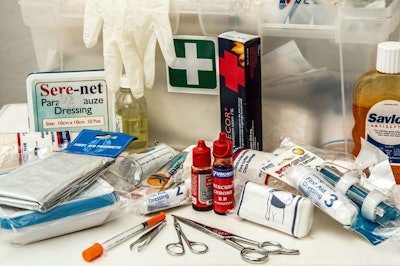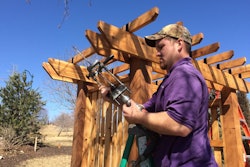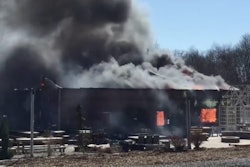

According to the Centers for Disease Control and Prevention, it is estimated that around 200 landscape service workers die each year as a result of workplace injuries. Although landscapers make up only 0.8 percent of the U.S. workforce, they experienced 3.5 percent of the total occupational fatalities.
Contact with objects and equipment
These injuries occur when workers are struck by, struck against, or caught in objects or equipment. Contact-related injuries can be sustained while using machinery to clear areas, trimming trees and bushes, sawing, digging or mowing.
If lacerations or cuts occur and medical attention is not immediately available, apply direct pressure to the wound to stop the bleeding. It is recommended that if possible, hands should be cleaned and medical gloves worn before touching an open wound. However, if gloves are not available, use many layers of clean cloth, plastic bags, or the cleanest material available between your hands and the wound.
While applying direct pressure, have the injured person lie down, remove any jewelry such as rings or bracelets that could disrupt blood flow, and elevate the bleeding area for 15 minutes. Remove any visible objects in the wound that are easy to remove, and clean the wound as best as you can.
While waiting for medical attention, watch for signs of shock: passing out or losing consciousness; dizziness or lightheadedness; weakness or having trouble standing; and being less alert.
Workplace falls
Landscapers face the possibility of falling out of a tree, falling off a ladder or plummeting into an open hole when they reach a jobsite. A cut or broken safety line or a tree branch breaking and falling are a few causes of workplace falls, and some injuries can also be caused by something as simple as tripping or stumbling.
If a co-worker has suffered a fall on the jobsite, be sure to call 911 immediately. Do not try to move them, but try to make them comfortable as possible and keep them warm. If a person has fallen from a lower height, bring a chair close by and help the person slowly move to rest in the chair. Make sure to keep a close watch in the following days, as symptoms can appear in the days following a fall even if it seems no harm was done.
After sustaining an injury or fall, workers should see a doctor if they lost consciousness just before or after the fall, have a strong or lingering pain, experience dizziness, nausea, headaches, vision problems or overall weakness.
Exposure to extreme temperatures
Landscapers work in myriad different environments, and exposure to extreme heat or cold can certainly take its toll. Those experiencing a heat stroke or hypothermia are not likely to recognize the symptoms, so it’s important for co-workers to watch for the warning signs so medical help can be contacted.
Symptoms may vary from person to person, but a few warning signs of a heat stroke can include nausea, dizziness, complaints of sudden and severe fatigue and lightheadedness. If a co-worker is suffering from a heat stroke, contact 911 immediately and find some method to cool him/her down.
If available, put the person in a cool tub of water, spray them gently with a garden hose, sponge them down with cool water, cover them with cool, damp sheets or place ice packs or cool, wet towels on the neck, armpits, and groin. If he/she is able to drink, keep him/her hydrated with cool water. If the person is unconscious, begin CPR until medical professionals can arrive.
Warning signs for hypothermia can also include complaints of nausea, dizziness, fatigue, euphoria, and irritability. Workers may also experience pain in their extremities and severe shivering.
If a co-worker is experiencing hypothermia, transport them to a warm location as fast as possible and call 911. Remove any wet clothing once you’ve reached the warm location and dry him/her off. Wrap the person in warm blankets, towels or coats, paying attention to the head and torso first.
If he/she is able to drink, find warm, non-alcoholic beverages; only offer the person a beverage if he/she is able to cough and swallow normally. Once the person’s body temperature has risen, be sure to keep him/her warm until medical help arrives.
Exposure to pesticides and chemicals
If used carelessly or not stored properly, pesticides and chemicals can be hazardous to the health of landscapers. Be sure to always read the label before working with pesticides, and follow the directions exactly, including all precautions and restrictions.
Be sure to use recommended protective measures when applying and handling pesticides, like wearing impermeable gloves, long pants, and long-sleeve shirts. After applying these substances to your job site, change clothes and wash your hands immediately after.
If the substances get in the eyes of a co-worker, it’s important to act quickly because eye damage can occur within minutes with some pesticides. Hold the eye open wide and gently wash it out with clean running water for at least 15 minutes. Also, contact the Poison Control Center as soon as possible. Do not to use any eye drops or any other kind of chemical to flush the eyes; use only water.
If the substance comes in contact with the skin, drench the area with water and quickly remove contaminated clothing. Wash the skin and hair thoroughly with soap and water, and later either discard the clothing or wash it separately from other laundry.
In the event of a co-worker inhaling a pesticide, carry him/her to fresh air immediately. Loosen the individual’s clothing; if the skin is blue or if the individual has stopped breathing, give CPR if you know how and call for medical attention immediately.
Electrical currents
Electrocution is possible when workers are digging or working with machinery and tools or when workers come into contact with overhead power lines. Exposure to electrical energy can result in absolutely no injury at all, or it can lead to severe damage or death depending on the situation.
Burns are the most common injury when dealing with electric shock. It is estimated that about 1,000 people in the U.S. die each year from being electrocuted, and most are due to on the job injuries.
If the voltage is less than 500 volts, it’s considered low voltage and does not normally cause significant injury to humans, but if the voltage is greater than 500 volts (high voltage) it has the potential to cause serious tissue damage.
If someone on your jobsite is electrocuted, seek medical attention immediately, and contact the local power company to notify them of the situation so the power can be temporarily shut off. While it may be your first instinct to help your co-worker, use extreme caution so you won’t become the second victim. If the terrain is wet and a high voltage line has fallen to the ground, currents can spread from the tip of the line.
Unless the person is in immediate danger, do not try to move them. If they show no signs of circulation such as breathing, coughing or movement, begin CPR. Try to prevent the injured person from becoming chilled, and apply bandages to any areas that were burned by the shock. Clean the burns with sterile gauze if available. Do not use a blanket or towel, because the loose fibers could stick to the burn.











